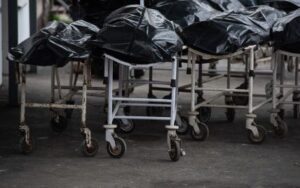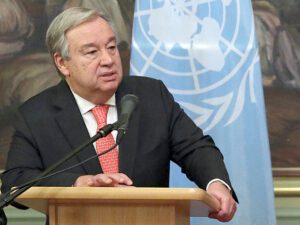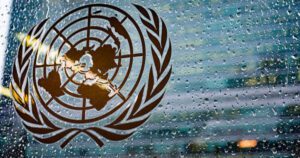
President of the European Parliament Roberta Metsola did not rule out that the war in Ukraine could lead to real famine in different regions of the world, and called on the heads of state and government of the EU countries to find ways to export food from Ukraine for export.
“The threat (of food insecurity) goes beyond Europe. It is possible that the world will face real hunger. If Ukraine is not allowed to work in its fields, we will face a global multi-year food shortage,” she said on Monday at an emergency EU summit.
Metsola accused Russia of blackmailing the whole world and “stealing” grain produced by Ukraine.
“We urgently need to find ways to ship grain from Ukraine to those regions of the world where it is most needed,” she urged. “We must expand the “corridors of solidarity” as announced by the European Commission, and explore other possibilities for the export of grain.”

Civilian casualties from February 24, when Russia started the war against Ukraine, to 24:00 on May 26 amounted to 8,766 civilians (a day earlier – 8,691), including 4,031 dead (3,998), reports the Office of the UN High Commissioner for Human Rights (OHCHR) on Friday.
“OHCHR believes that the actual figures are much higher as information is delayed from some areas of heavy fighting and many reports are still awaiting confirmation,” the UN data document notes.
According to him, this applies, for example, to Mariupol (Donetsk region), Izyum (Kharkiv region) and Popasna (Luhansk region), where there are reports of numerous civilian casualties. They are subject to further verification and are not included in the above statistics.
“The majority of civilian deaths or injuries were caused by the use of explosive devices with a wide area of effect, including shelling from heavy artillery and multiple launch rocket systems, as well as rocket and air strikes,” the report says.
According to confirmed UN figures, 1,529 men, 995 women, 100 boys and 92 girls died, while the sex of 69 children and 1,246 adults has not yet been determined.
Among the 4,735 injured were 132 boys and 110 girls, as well as 164 children whose gender has not yet been determined.
Compared to the report two days earlier, a child died and two more were injured.
OHCHR indicates that in Donetsk and Luhansk regions, as of midnight on May 27, there were 2,145 (2,122) dead and 2,132 (2,124) injured in government-controlled territory, and 129 (129) dead and 541 (537) injured in territory controlled by self-proclaimed “republics”.
In other regions of Ukraine under government control (in Kyiv, as well as in Zhytomyr, Zaporozhye, Kyiv, Sumy, Odessa, Mykolaiv, Kharkiv, Kherson, Dnipropetrovsk, Cherkasy and Chernihiv regions), the UN recorded 1757 (1747) dead and 2062 (2032) wounded .
The summary traditionally states that the increase in the figures from the previous summary should not be attributed only to the May 26 cases, since during this period the Office verified a number of cases from previous days.

Losses among civilians from February 24, when Russia started the war against Ukraine, to 24:00 on May 22 amounted to 8,462 civilians (three days earlier – 8,189), including 3,930 dead (3,838), according to the Office of the UN High Commissioner. on Human Rights (UNHCR) on Monday.
“OHCHR believes that the actual figures are much higher as information from some places of intense fighting is delayed and many reports are still awaiting confirmation,” the document said.
According to him, this applies, for example, to Mariupol (Donetsk region), Izyum (Kharkiv region) and Popasnaya (Luhansk region), where there are reports of numerous casualties among the civilian population. They are subject to further verification and are not included in the above statistics.
“The cause of most civilian deaths or injuries was the use of explosive devices with extensive damage, including heavy artillery shelling and multiple rocket launchers, as well as missiles and air strikes,” the statement said.
According to confirmed UN data, 1,482 men, 973 women, 98 boys and 90 girls died, while the sex of 69 children and 1,218 adults has not yet been determined.
Among the 4,532 injured were 124 boys and 106 girls, as well as 164 children, the sex of whom has not yet been established.
Compared to the summary, three days earlier the child died and 11 others were injured.
UNHCR notes that at midnight on 23 May, 2,072 (1992) deaths and 2003 (1,872) injuries were recorded in Donetsk and Luhansk oblasts in government-controlled territory, and 128 (127) deaths and 522 (509) wounded in self-proclaimed territories. “republics”.
In other regions of Ukraine under government control (in Kiev, as well as in Zhytomyr, Zaporizhia, Kyiv, Sumy, Odessa, Mykolaiv, Kharkiv, Kherson, Dnipropetrovsk, Cherkasy and Chernihiv regions) the UN recorded 1730 (1719) dead and 2007 (1970) wounded .
The summary traditionally states that the increase in the previous summary should not be attributed only to the cases of May 20-22, as during this period the Office verified a number of cases for the previous days.

The restaurant market in Kyiv has shrunk by half, since the beginning of the war at least a third of establishments have been closed, Olga Nasonova, co-founder of the National Restaurant Association of Ukraine, told Interfax-Ukraine.
“At best, half of the 500,000 active consumers of restaurant services have remained. This means that half of the market simply does not have its own audience, it does not exist now physically. Restaurant Kyiv today is a city of harsh contrasts. A dead desert with closed doors of cafes and restaurants is enlivened by oases of crowded establishments. At least a third of Kyiv restaurants are closed. It is not known when they will open,” Nasonova said.
According to her observations, only about 20% of open catering establishments show a good load. “From central Kyiv, these are Keds, Musafir, Milk Bar, Mimosa, Arugula, Naprosecco – I won’t mention everyone, but everyone who was downtrodden was doing well before the war,” says Nasonova .
In addition to such top establishments even before the war, according to her estimates, two formats have a chance to “survive”.
“Coffee shops and bakeries will hold out. Low average bill, small area. Chains such as Family Bakery, Lviv Croissants, Espressoholik, Aroma Kava” will be fine with them. Establishments with the concept of simple and hearty cuisine are in demand: “Musafir”, “Mama Manana” (Georgia), “Puzata Khata” … But exotic concepts are now in much less demand, it’s like pampering, or something. Sushi, ramen – it’s more about pampering yourself from time to time, “Nasonova said .
The expert also noted that the curfew practically stopped the work of bars in the capital.
“It’s hard to get used to drinking before 9 pm,” Nasonova said.
At the same time, kiosks with shawarma feel best of all.
“Simple and cheap food is the trend of the coming months, and single men are the main audience,” says the expert.
As for prices, since the beginning of the war, prices for the most democratic positions have already increased by about 10%.
“The (Kyiv) perepichka index is growing – already 30 hryvnias, at the end of 2021 it was 25 hryvnias. For economists, these figures speak volumes. Coffee prices began to rise from the beginning of the year, cappuccino in January was 32 hryvnias, in March it was already 35 hryvnias, in the center now UAH 38,” Nasonova said.
Established in 2021, the National Restaurant Association of Ukraine (NRAU) for May 2022 unites more than 50 members, 450 restaurants and cafes.

The situation in Ukraine “has devastated food supplies, disrupted the energy and financial systems of developing countries,” UN Secretary General António Guterres said.
“In fact, there is no real solution to the problem of global food security, unless the agricultural producer Ukraine, as well as food and fertilizer producers Russia and Belarus, are returned to the world market,” Western media quote the words of the UN Secretary General during his trip to Nigeria.
Guterres added that he was determined to promote dialogue on this issue.

Civilian casualties from February 24, when Russia started the war against Ukraine, to 24:00 on April 27 amounted to 6,009 civilians (in the report the day before – 5,939), including 2,829 dead (2,787), reports the Office of the High Commissioner United Nations Human Rights Organization (OHCHR) on Thursday.
“OHCHR believes that the actual figures are much higher as information is delayed from some areas of heavy fighting and many reports are still awaiting confirmation,” the UN data document notes.
According to him, this applies, for example, to Mariupol (Donetsk region), Izyum (Kharkiv region) and Popasna (Luhansk region), where there are reports of numerous civilian casualties. They are subject to further verification and are not included in the above statistics.
“The majority of civilian deaths or injuries were caused by the use of explosive devices with a wide area of effect, including shelling from heavy artillery and multiple launch rocket systems, as well as rocket and air strikes,” the report says.
According to confirmed UN data, 932 men, 626 women, 75 boys and 62 girls died, while the sex of 68 children and 1066 adults has not yet been determined.
Among the 3,180 wounded were 73 boys and 66 girls, as well as 164 children whose gender has not yet been determined.
Compared to Friday’s report, according to the UN, three children were killed and another was injured.
OHCHR indicates that in Donetsk and Luhansk regions, as of midnight on April 28, there were 1,266 (1,229) dead and 1,172 (1,159) injured in government-controlled territory, and 88 (85) dead and 357 (353) injured in territory controlled by self-proclaimed “republics”.
In other regions of Ukraine under government control (in Kyiv, as well as in Zhytomyr, Zaporozhye, Kyiv, Sumy, Odessa, Mykolaiv, Kharkiv, Kherson, Dnepropetrovsk, Cherkasy and Chernihiv regions), the UN recorded 1475 (1473) dead and 1651 (1640) wounded .
The daily summary traditionally states that the increase in the figures from the previous summary should not be attributed only to the cases on April 26, since during this period the Office verified a number of cases from previous days.